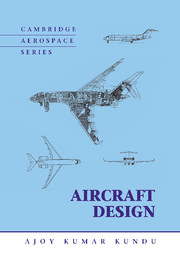Book contents
- Frontmatter
- Contents
- List of Symbols and Abbreviations
- Preface
- Road Map of the Book
- 1 Introduction
- 2 Methodology to Aircraft Design, Market Survey, and Airworthiness
- 3 Aerodynamic Considerations
- 4 Aircraft Classification, Statistics, and Choices for Configuration
- 5 Aircraft Load
- 6 Configuring Aircraft
- 7 Undercarriage
- 8 Aircraft Weight and Center of Gravity Estimation
- 9 Aircraft Drag
- 10 Aircraft Power Plant and Integration
- 11 Aircraft Sizing, Engine Matching, and Variant Derivative
- 12 Stability Considerations Affecting Aircraft Configuration
- 13 Aircraft Performance
- 14 Computational Fluid Dynamics
- 15 Miscellaneous Design Considerations
- 16 Aircraft Cost Considerations
- 17 Aircraft Manufacturing Considerations
- Appendix A Conversion
- Appendix B International Standard Atmosphere
- Appendix C Aerofoils
- Appendix D Case Studies
- Appendix E Tire Data
- References
- Index
16 - Aircraft Cost Considerations
Published online by Cambridge University Press: 05 June 2012
- Frontmatter
- Contents
- List of Symbols and Abbreviations
- Preface
- Road Map of the Book
- 1 Introduction
- 2 Methodology to Aircraft Design, Market Survey, and Airworthiness
- 3 Aerodynamic Considerations
- 4 Aircraft Classification, Statistics, and Choices for Configuration
- 5 Aircraft Load
- 6 Configuring Aircraft
- 7 Undercarriage
- 8 Aircraft Weight and Center of Gravity Estimation
- 9 Aircraft Drag
- 10 Aircraft Power Plant and Integration
- 11 Aircraft Sizing, Engine Matching, and Variant Derivative
- 12 Stability Considerations Affecting Aircraft Configuration
- 13 Aircraft Performance
- 14 Computational Fluid Dynamics
- 15 Miscellaneous Design Considerations
- 16 Aircraft Cost Considerations
- 17 Aircraft Manufacturing Considerations
- Appendix A Conversion
- Appendix B International Standard Atmosphere
- Appendix C Aerofoils
- Appendix D Case Studies
- Appendix E Tire Data
- References
- Index
Summary
Overview
An aircraft design, construction, and operation is an expensive endeavor, and not all nations can afford it. Countries that can must be cost-conscious, whether in a totalitarian or a free-market-economy society – the ground rules for accounting may differ but all strive for the least expensive endeavor for the task envisaged. The success or failure of an aircraft project depends on its cost-effectiveness. Cost-consciousness starts in the conceptual design phase to ensure competitive success. In fact, cost estimation should start before the conceptual design phase in a topdown analysis. If funds cannot be managed through the end of the project, then starting it is not viable.
Visibility on costing forces long-range planning and provides a better understanding of the design's system architecture for trade-off studies to explore alternate designs and the scope for sustainability and eco-friendliness of the product line. The product passes through well-defined stages during its lifetime: conception, design, manufacture, certification, operation, maintenance and modification, and finally disposal at the end of the life cycle. Cost information for previous products should be sufficiently comprehensive and available during the conceptual stages of a new project. The differential evaluation of product cost and technology – offering reliability and maintainability – as well as risk analysis are important considerations in cost management. Cost details also assist preliminary planning for procurement and partnership sourcing through an efficient bidding process. The final outcome ensures acquisition of an aircraft and its components with the objective of balancing the trade-off between cost and performance, which eventually leads to ensuring affordability and sustainability for operators over a product's life cycle.
- Type
- Chapter
- Information
- Aircraft Design , pp. 523 - 550Publisher: Cambridge University PressPrint publication year: 2010



